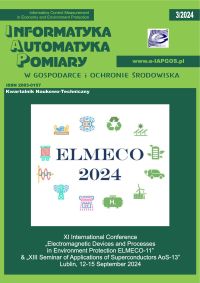ZASTOSOWANIE SIECI NEURONOWYCH RESNET-152 DO ANALIZY OBRAZÓW Z UAV DO WYKRYWANIA POŻARU
Nataliia Stelmakh
n.stelmakh@kpi.uaNational Technical University of Ukraine “Igor Sikorsky Kyiv Polytechnic Institute” (Ukraina)
https://orcid.org/0000-0003-1876-2794
Svitlana Mandrovska
National Technical University of Ukraine “Igor Sikorsky Kyiv Polytechnic Institute” (Ukraina)
https://orcid.org/0009-0005-2354-9965
Roman Galagan
National Technical University of Ukraine “Igor Sikorsky Kyiv Polytechnic Institute” (Ukraina)
https://orcid.org/0000-0001-7470-8392
Abstrakt
Wczesne wykrycie pożarów w środowisku naturalnym (w tym pożarów na gruntach rolnych) jest zadaniem pilnym, gdyż ich niekontrolowany rozwój może spowodować znaczne szkody. Obecnie głównymi podejściami do wykrywania pożarów jest wizualna analiza przez człowieka strumienia wideo w czasie rzeczywistym z bezzałogowych statków powietrznych lub analiza obrazu satelitarnego. Pierwsze podejście nie pozwala na automatyzację procesu wykrywania pożaru i uwzględnia czynnik ludzki, natomiast drugie podejście nie pozwala na wykrycie pożaru w czasie rzeczywistym. Artykuł poświęcony jest zagadnieniu przydatności wykorzystania sieci neuronowych do rozpoznawania i wykrywania źródła pożaru na podstawie analizy obrazów uzyskiwanych w czasie rzeczywistym z kamer małych bezzałogowych statków powietrznych. Zapewnia to automatyzację wykrywania pożaru, zwiększa efektywność tego procesu oraz zapewnia szybką reakcję na wystąpienie pożarów, co ogranicza ich niszczycielskie skutki. W artykule proponujemy wykorzystanie splotowej sieci neuronowej ResNet-152. Aby przetestować wydajność wyszkolonego modelu sieci neuronowej wykorzystaliśmy ograniczony testowy zbiór danych, którego charakterystyka znacznie różni się od zbiorów danych treningowych i walidacyjnych. Tym samym wytrenowana sieć neuronowa została poddana celowo trudnym warunkom operacyjnym. Jednocześnie uzyskano parametry "Precision" – 84.6%, "Accuracy" – 91% i "Recall" – 97.8%.
Słowa kluczowe:
UAV, sieć neuronowa, ResNet-152, wizja komputerowa, sztuczna inteligencja, detekcja pożaruBibliografia
Bezugla N. et al.: Biological Tissues Axial Anisotropy Spatial Photometry. Bezuglyi M. et al. (eds): Advanced System Development Technologies I. Studies in Systems, Decision and Control 511, Springer 2024 [https://doi.org/10.1007/978-3-031-44347-3_5].
Google Scholar
Bezuglyi M. et al.: Ellipsoidal Reflectors for Biological Media Light Scattering Photometry. Bezuglyi M. et al. (eds): Advanced System Development Technologies I. Studies in Systems, Decision and Control 511, Springer 2024 [https://doi.org/10.1007/978-3-031-44347-3_4].
Google Scholar
Bondariev D. et al.: Optical Properties of Light-Scattering Standards for CCD Photometry. Sensors 23, 2023, 7700 [https://doi.org/10.3390/s23187700].
Google Scholar
Cabezas M. et al.: Detection of invasive species in wetlands: practical DL with heavily imbalanced data. Remote Sensing 12(20), 2020, 3431 [https://doi.org/10.3390/rs12203431].
Google Scholar
Eisenbeiss H.: A mini unmanned aerial vehicle (UAV): system overview and image acquisition. International Archives of Photogrammetry. Remote Sensing and Spatial Information Sciences 36(5), 2004, 1–7.
Google Scholar
Hasanah S. A. et al.: A Deep Learning Review of ResNet Architecture for Lung Disease Identification in CXR Image. Applied Sciences 13(24), 2023, 13111 [https://doi.org/10.3390/app132413111].
Google Scholar
He K. et al.: Deep residual learning for image recognition. Proceedings of the IEEE conference on computer vision and pattern recognition, 2016, 770–778.
Google Scholar
https://github.com/UIA-CAIR/Fire-Detection-Image-Dataset (available: 29.03.2024).
Google Scholar
Khan A. et al.: A survey of the recent architectures of deep convolutional neural networks. Artificial intelligence review 53, 2020, 5455–5516.
Google Scholar
Liu W. et al.: SSD: Single shot multibox detector. 14th European Conference Computer Vision–ECCV, Part I 14, 2016, 21–37.
Google Scholar
Mascarenhas S., Agarwal M.: A comparison between VGG16, VGG19 and ResNet50 architecture frameworks for Image Classification. International Conference on Disruptive Technologies for Multi-Disciplinary Research and Applications (CENTCON), 2021, 96–99 [https://doi.org/10.1109/CENTCON52345.2021.9687944].
Google Scholar
Redmon J. et al.: You only look once: Unified, real-time object detection. IEEE conference on computer vision and pattern recognition, 2016, 779–788.
Google Scholar
Sharma J. et al.: Deep convolutional neural networks for fire detection in images. Communications in Computer and Information Science 744, 2017 [https://doi.org/10.1007/978-3-319-65172-9_16].
Google Scholar
Stelmakh N. et al.: Features of the implementation of computer vision in the problems of automated product quality control. Informatyka, Automatyka, Pomiary w Gospodarce i Ochronie Środowiska 13(1), 2023, 38–41 [http://doi.org/10.35784/iapgos.3434].
Google Scholar
Wonjae L. et al.: Deep neural networks for wild fire detection with unmanned aerial vehicle. IEEE international conference on consumer electronics (ICCE), 2017, 252–253 [https://doi.org/10.1109/ICCE.2017.7889305].
Google Scholar
Zhang L. et al.: Is faster R-CNN doing well for pedestrian detection? 14th European Conference Computer Vision–ECCV, Part II 14, 2016, 443–457.
Google Scholar
Autorzy
Nataliia Stelmakhn.stelmakh@kpi.ua
National Technical University of Ukraine “Igor Sikorsky Kyiv Polytechnic Institute” Ukraina
https://orcid.org/0000-0003-1876-2794
Nataliia Stelmakh
Ph.D., Associate professor in Department of Device Production, National Technical University of Ukraine “Igor Sikorsky Kyiv Polytechnic Institute”. Received PhD degree thesis in unique "Engineering Technology" in 2010. Author of more than 50 scientific papers, and 12 patents for utility models. Research interests: automation and computer-integrated technologies, assembly of devices and preparation of production, computer vision.
Autorzy
Svitlana MandrovskaNational Technical University of Ukraine “Igor Sikorsky Kyiv Polytechnic Institute” Ukraina
https://orcid.org/0009-0005-2354-9965
Svitlana Mandrovska received a master's degree in automation and computer-integrated technologies from the National Technical University of Ukraine "Kyiv Polytechnic Institute", Faculty of Instrumentation (Ukraine).
Research interests: study of computer vision for production processes, machine learning, neural networks.
Autorzy
Roman GalaganNational Technical University of Ukraine “Igor Sikorsky Kyiv Polytechnic Institute” Ukraina
https://orcid.org/0000-0001-7470-8392
Associate professor in Department of Automation and Non-Destructive Testing Systems the Faculty of Instrumentation Engineering, National Technical University of Ukraine "Igor Sikorsky Kyiv Polytechnic Institute".
Author and co-author of more than 40 scientific papers, 1 monograph and 1 textbook. Research interests: programming, machine learning, non-destructive testing, computer vision, data analysis.
Statystyki
Abstract views: 155PDF downloads: 109
Inne teksty tego samego autora
- Nataliia Stelmakh, Ihor Mastenko, Olga Sulima, Tetiana Rudyk, CECHY IMPLEMENTACJI WIDZENIA KOMPUTEROWEGO W PROBLEMACH AUTOMATYCZNEJ KONTROLI JAKOŚCI PRODUKTÓW , Informatyka, Automatyka, Pomiary w Gospodarce i Ochronie Środowiska: Tom 13 Nr 1 (2023)
- Nataliia Stelmakh, Oleg Belman, ROZWÓJ AUTOMATYZACJI SORTOWANIA ODPADÓW JAKO INTEGRALNA CZĘŚĆ OCHRONY ŚRODOWISKA , Informatyka, Automatyka, Pomiary w Gospodarce i Ochronie Środowiska: Tom 12 Nr 2 (2022)









